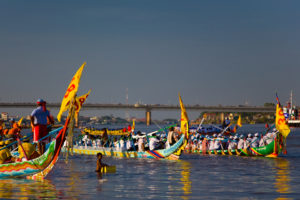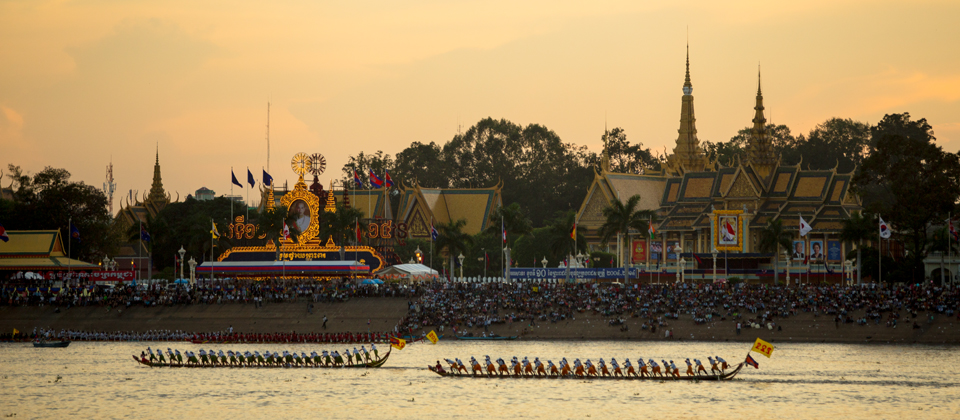

2025 Nov 4th-6th Water Festival.
Over the years, many reasons have been used to cancel this event. If the main races in Phnom Penh do not go ahead, I expect many smaller races throughout the provinces of Cambodia, including Siem Reap. The dates are public holidays so expect roads / transportation to be busy.
I hope to visit Kampong Khleang to get some unique footage of this event.

Racers return, 2009. Note the shacks over the river, now gone.
A festival marking the end of rainy season, celebrated by millions on waterways across Cambodia. Bon Om Tuk is the third largest festival in the Kingdom after Khmer New Year and Pchum Ben, ancestors day. It is combined with Khmer ceremony ‘Sampeah Preah Khae’, the cooking of a special rice dish ‘Ak Ambok’ and the saluting the full moon at midnight in pagodas across the country.

A local fishing amongst the madness
Bon Om Tuk dates back to the King Jayavaraman VII era when the country was at war with Champa, a former country between the Kingdom of Cambodia and Vietnam, the Battles being fought on the water. The reliefs on the walls of Bayon depict the story. The boat racing stems from the training of soldiers, where the King would hold a competitive event to choose the fittest soldiers for battle.

Khmer delicacies
Boat racing can be witnessed all over the country, but by far the biggest and best racing is in the capital, Phnom Penh. Here, crowd numbers have been measured in millions with over 400 boats competing. 2010 saw increased crowd numbers, with whole villagers arriving to see the newly formed Koh Pic (diamond island), which tragically led to the bridge disaster. Hundreds of Khmers lost their lives when panic spread at the bridge to Koh Pic causing a stampede. Since then, due to various reasons, the festival in Phnom Penh has only ben held once, in 2014, where crowd numbers and race participants were significantly lower. The festival was due to go ahead in 2015, but was cancelled last minute due to ‘low’ water levels. Hopefully this festival will continue in the future as it is an important part of Khmer culture, but this depends on the powers that be, not keen on disruption in the capital.
Diary extract 2010:
“Watching the celebrations on the final evening I was by the river in the royal enclosure, unaware of the swelling crowds that evening. The main festival ended with fireworks at 8pm. It  was time to get back to the guesthouse near Sroya Mall, a few blocks back. However, with the volume of spectators by the river, we were penned in. It took an hour to get back one block in the mass sway of people, then I hopped on a motodop for the next few blocks, it would have been quicker to walk.. Finally at 11pm, after dropping my kit off, I settled down for a beer in a local bar. By 11.30pm, horrific scenes started appearing on a national TV channel of the bridge disaster happening just down from where I had been sitting, terrible for these beautiful Khmers.”
was time to get back to the guesthouse near Sroya Mall, a few blocks back. However, with the volume of spectators by the river, we were penned in. It took an hour to get back one block in the mass sway of people, then I hopped on a motodop for the next few blocks, it would have been quicker to walk.. Finally at 11pm, after dropping my kit off, I settled down for a beer in a local bar. By 11.30pm, horrific scenes started appearing on a national TV channel of the bridge disaster happening just down from where I had been sitting, terrible for these beautiful Khmers.”

Local spectators
In the capital, days before the main event, large boats start arriving with their race boats in tow, sometimes with complete villages on board. It’s a big event and quite a celebration, traditional music and plenty of alcohol, with the vast majority of revellers in good spirits. Race day commence with pairs of boats sometimes carrying more than one hundred oarsmen competing to the rhythm of banging drums.
The first day is usually fairly quite, crowds on the bank of Sisowath Quay increase towards the evening. At 7pm, large boats are illuminated and paraded up and down the river, Khmers call this ‘Bandaet Pratip’ (illuminating boats), a tradition that dates back centuries. Each boat representing a government department. Fireworks in abundance, the Khmers like their explosives. Theres a mixture of Khmer events around the city, drawing crowds, advertisers & some rather loud music, typically Khmer.

Dancers on the boats
Visiting during this time can be interesting. Due to crowd numbers, however, many people choose to stay away. For a photographer it can be a great experience. If you choose Phnom Penh, be aware that over the three day festival, visitor numbers swell as time goes on, culminating on the evening of the third day, where crowds can fill several blocks from the riverside. If you are on the rivers edge, theres a good chance you may get stuck in the crowds, look after your valuables.
On the final day the winners are announced and met on the banks of the river by the King. It’s spectacular, apsara dancers parade to rhythmic drums at the bow of race boats, cheered on by the now huge crowds. More fireworks, more celebrating into the night, hopefully without incident.
 Visiting Phnom Penh is great, but be aware of crowd numbers. It’s easy to not notice the build up of people behind you while watching the racing. Being trapped in a sea of people is not nice. Common sense must prevail, it is difficult to comprehend the sheer volume of of people that can converge on the capital for this very special, historic event.
Visiting Phnom Penh is great, but be aware of crowd numbers. It’s easy to not notice the build up of people behind you while watching the racing. Being trapped in a sea of people is not nice. Common sense must prevail, it is difficult to comprehend the sheer volume of of people that can converge on the capital for this very special, historic event.

Fireworks every evening
Boat racing is held throughout the country, with a smaller event in Siemreap, kinder to the first time tourist. Here, the festival is only celebrated on the first two days. Smaller crowds gather by the river and a few Khmer events are held around the city, including the mandatory loud music. Siemreap is gaining in popularity amongst those in the capital escaping the crowds of their
home, so guest houses can fill with locals.
If cultural events are your thing, then Bon Om Tuk is a great experience, witnessing a unique part of Khmer culture. If you plan on visiting, be sure to plan ahead as a public transport can be limited with masses of locals moving before and after the event to get to their desired location. Be aware that political decisions may affect celebrations, more so in the capital. The festival is held in good spirits, and an important part of Khmer history, long may it continue.
Best time to visit Angkor Wat – Seasons explained.
Check out these 6 stunning photographs of Angkor Wat, including camera settings!
You may also like Angkor Wat survival guide for photographers.

Pleasant crowds in 2014 compared to earlier years

Racing to the finish line near the royal palace

Welcoming home the winning team.

2 comments. Leave new
I too hope the festival will be held this year despite the increasing political tension as I believe it to be very unlikely during election year… And I hope it is just my imagination that the government is sifting bigger holidays to weekends as much as possible, denying hard working Khmers the chance to visit their homes (travel to provinces is slow and painstaking) and reinforce family ties.
Yep, it’s a great event for the locals. Public holidays now seem to be used for political propaganda, sonkrant at Angkor being laughable, & the generous government giving 4 days holiday, not 3.